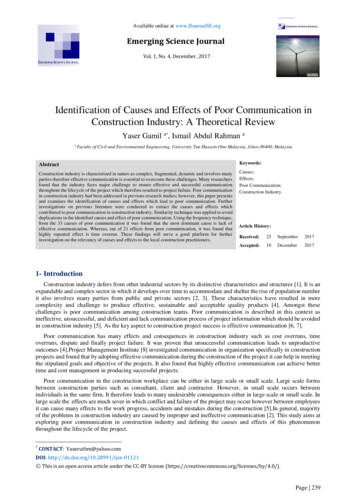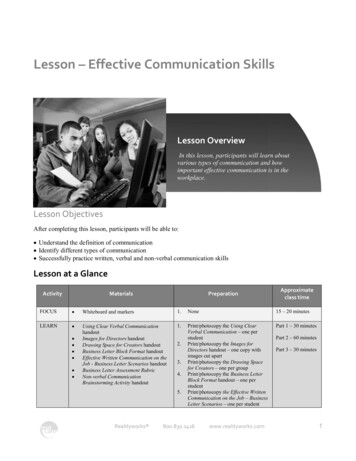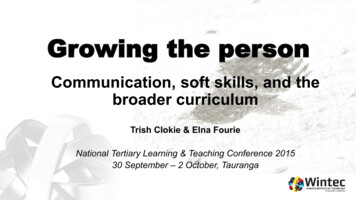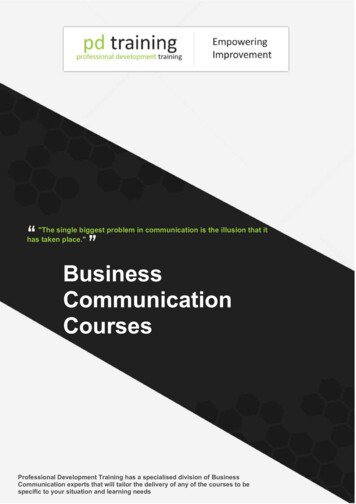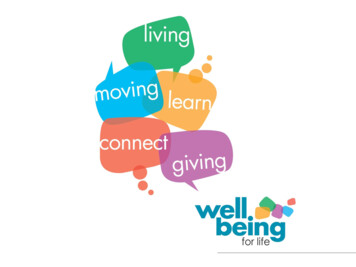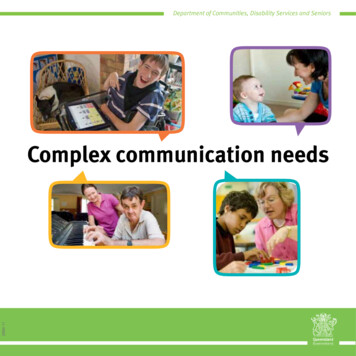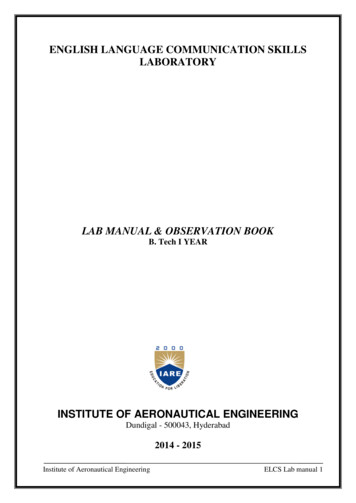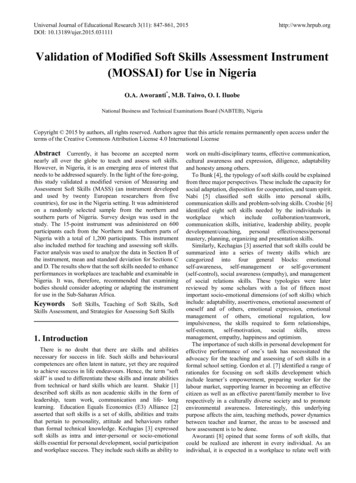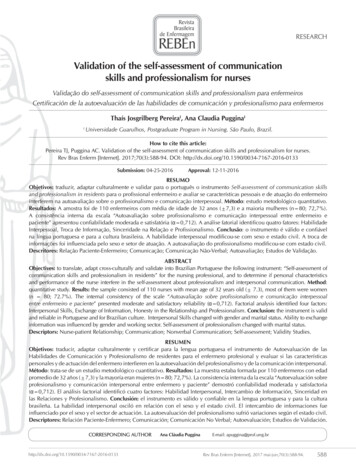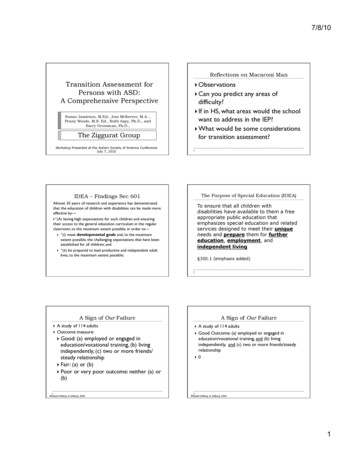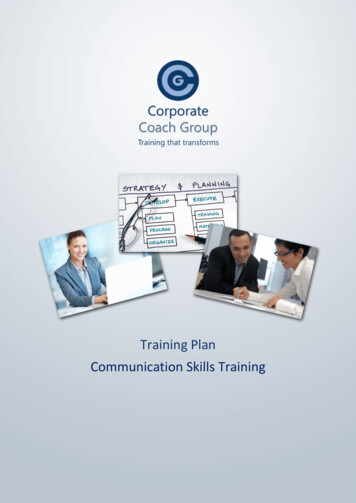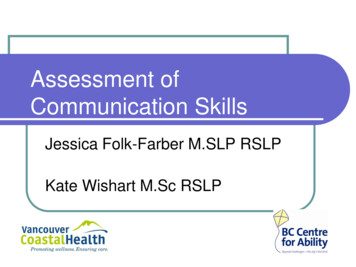
Transcription
Assessment ofCommunication SkillsJessica Folk-Farber M.SLP RSLPKate Wishart M.Sc RSLP
Learning ObjectivesParticipants will understand The ICF Framework as it relates toassessment of children’s communicationskills That assessment involves a focusbeyond the child performance instructured tasks including evaluation inreal life situations And of communication partners
What is Language?Language is not a single entity Form grammar/structure Content words Function use of language inappropriate context Without all three, there is no sharedcommunication
Language is more than just words and sentences Most of us communicate through speech Some communicate through sign We all use Body language Gestures Facial expression Tone (prosody)
Communication isboth use oflanguage andcomprehension oflanguage Talking ANDlistening
What is language?FormSounds and grammarUseLanguage FunctionsAppropriateness of LanguageContentWords
Communication in Context Bloom & Tinker (2001) add effort –cognitive development – andengagement – social & emotionaldevelopment – as a broader frameworkfor considering language development Language-learning occurs within thecontext of the child’s abilities
The Intentionality Model – Bloom andTinker (2001)FORMUSEENGAGEMENT:Social & EmotionalDevelopmentEFFORT:Cognitive DevelopmentCONTENT
Learning Language is Interactive Content: children must be repeatedly exposedto new words in context in order to map theminto their lexicon Form: children must be repeatedly exposed togrammatical structures to map the rules oftheir native language Function: children must have opportunities totry, succeed, and fail at communicationattempts in order to learn what is appropriate
Learning Spoken Words The child must connect the soundsequences he/she hears with the objector idea – the meaning Child’s system of sound production develops tomatch adult system
Delay vs. DisorderDelayDisorder Child’s language or Child’s language orspeech soundspeech soundsystem is developingsystem is notin the expecteddeveloping in thesequence, but isexpected sequencebehind that of his orher peers Child’s language orspeech reflects thatof the chronologicallyyounger child
The Child’s Needs PhysicalHearing Structure of oral-motor mechanisms Breath support, lung capacity Muscle tone Cognitive Social-Emotional Models Partners
Input: From AdultsLanguage-learning occurs in context Caregivers: structure the environment to facilitatelanguage development model language and pair verbal input withvisual cues to help child make connectionsbetween words and objects/events create opportunities throughout the day
Input: From PeersLanguage-learning occurs in context Peers: Model language at a level similar to wherechildren are speaking now Engage each other in social interactionsand pretend-play sequences Frequently refuse or ignore others’ attemptsat communication and joining in play
Communication Partners Two roles: as receiver and as sender ofmessages Always within context of the environment
The Communication ModelActivity and t
Scene 1: Child & Teacher ATeacher: What do you have?Child: CarTeacher: What colour is it?Child: BlueTeacher: Did you get it at the store?Child: No mummyTeacher: Mummy gave it to you?Child: Yes
Scene 2: Child & Teacher BTeacher: What do you have? Child: Car Teacher: Oh, it’s a blue car! Child: Blue car. Fast! Teacher: A fast blue car! A racecar. Child: Racecar. Blue racecar. Teacher: Can you show me how itraces? Child: Races fast. Vroom.
Scene 3: Child & Child B Child: Car Child B: My car! Child: Car Child B: My car! and so on!!!
Importance of Interaction Dickinson (2002) showed that improvedinteractions between teachers andpreschool students leads to greateracademic success in the later years,including in literacy Hart & Risley: The Early Catastrophe
The Speech ChainDenes & Pinson, p.5
International Classification of Functioning,Disability & Health (ICF) A model that helps bridge the worlds offunders, families and clinicians to explain ourassessment, intervention goals and outcomes Common language for all Health-based inclusive of all of us,not just those with ‘disabilities’
Child Abilities & CommunicationEnvironments
ICFTo improve child functioning: a disability model emphasizes changingor mitigating individuals’ deficits as away of improving their functioning a health and social model whichemphasizes changing the environmentaround the individual, to support theirimproved functioning and participation
ICF
ICFHealth Condition(disorder/disease)Body functionand tors
The Speech ChainICF Body/Structure Function Level
Body Functions (Impairment) Improving oral motor control Producing new sounds Improving eye gaze Improving pointing Jenny will identify objects by colour andsize Joseph will use grammatical markers
Body structure? Body function? Activities? Participation?
Communicative Participation Performancein actual lifesituationin contrast to Capacity in controlled activitiessuch as clinic or therapyWHO, 2007, pp. xvi, 12
Activity‘Capacity’ – optimal ability to perform a taskin a standard environment, such as thespeech clinic. Increased vocabulary Increased sentence length Use of grammar in structured tasks Increased fluency
Participation‘Performance’: what someone typically does in all oftheir environments More sociable Starting to play with other children at child care setting Talking more to other people in the stores or at familygatherings Taking more communication turns when playing at childcare Following the teacher’s instructions at school
Personal FactorsBiological preparationfor language. perceptual, attention, memory cognitive capacities motivation individual child traits personalityInterests
Environmental factors Linguistic factorsParental communicationstyleLanguage input-quantity-qualityAttitudes of family, peers, society beliefsvaluescustoms
Community participation and life satisfaction ofindividuals with disabilities People with disabilities are just like everyone else." "Remember the person is an individual first and disabledsecond." "We are people. We have feelings, hopes, desires, andneeds like everyone and what we need most is acceptanceand support, financially and emotionally."What Helps and Hinders People at Turning Points in Life? (1999) King, G., Cathers, T., MacKinnon, L., Havens, L., Smith, L., Brown, L.,Specht, J., Miller Polgar, J., & Willoughby, C., CanChild Centre for Childhood Disability Research
Standardized assessments:where do they fit?Communicative CapacityCommunication Performance
CFCS Communication Function ClassificationSystem for Individuals with Cerebral Palsy Classifies the everyday communicationperformance of an individual with cerebralpalsy into one of five levels Focuses on activity and participation levelshttp://www.cfcs.us/
CFCS Level Identification ChartDoes the personconsistently andeffectively alternatesender and receiver roleswith familiar partnersYESDoes the personconsistently andeffectively communicatewith unfamiliar partners?YESYESLevel IEffective Sender andReceiver withunfamiliar andfamiliar partnersIs the person an effectivesender AND/OR areceiver at least some ofthe time?NODoes the person usuallymaintain a comfortableconversational pace withcommunication partnersNOLevel IIIEffective Sender ANDEffective Receiverwith familiar partnersNOLevel IIEffective, but slowerpaced Sender and/orReceiver with unfamiliarand familiar partnersYESLevel IVInconsistent Senderand/or Receiver withfamiliar partnersNOLevel VSeldom EffectiveSender and Receiverwith familiar partners
FOCUSF ocus on theO utcomes ofC ommunicationU nderS ix A new outcomemeasure forpreschool childrenthat identifies ‘realworld’ changesassociated withspeech profiles/thomasstonell.php
FOCUS Measures changes in ‘participation-level’real-world communication skills 50 item questionnaire Completed by clinician and parent Takes 10 minutes to complete* Thomas- Stonell, N, Oddson, B., Robertson B., Rosenbaum, P.,(2009) Predicted and observed outcomes in preschool childrenfollowing speech and language treatment. Journal ofCommunication Disorders, 42, 29-42
Participation –every child’s goal The child The family The environmentLaw, M., & King, G. (2000), Participation!Every child's goal. Today's Kids in Motion,1, 10-12
Stumbling blocks: Speech/language delayand participation in physical activities ChildUnderstanding oflanguage – rulesAbility to expressideasSocial communicationProcessing EnvironmentNoise levelActivity levelNeeds of others inenvironmentAbilities of others inenvironment
What does this mean forintervention? Consider:Where we do treatment How we do treatment How we frame goals of treatment Increased role of family and othercaregivers in treatmentIncreased role of teachers Increased role of peers
real-world communication skills 50 item questionnaire Completed by clinician and parent Takes 10 minutes to complete * Thomas- Stonell, N, Oddson, B., Robertson B., Rosenbaum, P., (2009) Predicted and observed outcomes in preschool children following speech and language treatment. Journal of Communication Disorders, 42, 29-42
